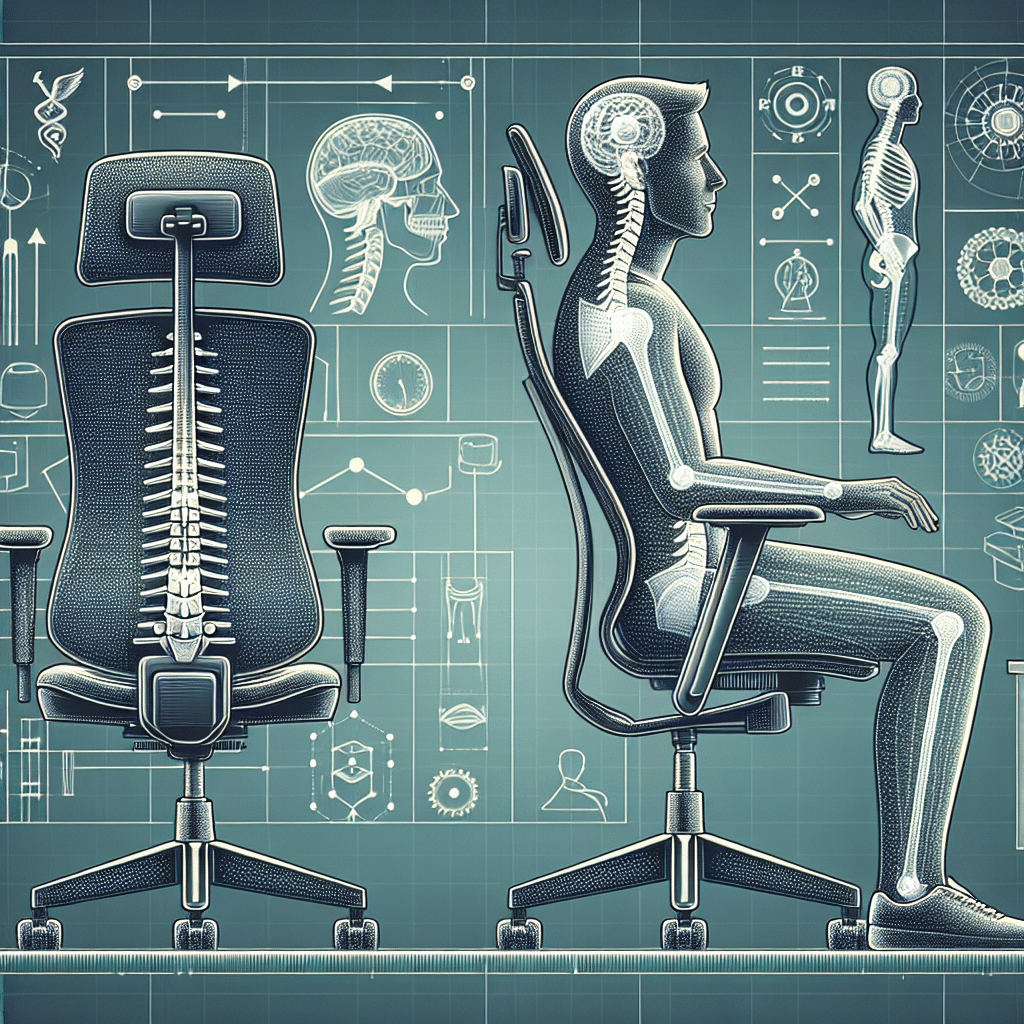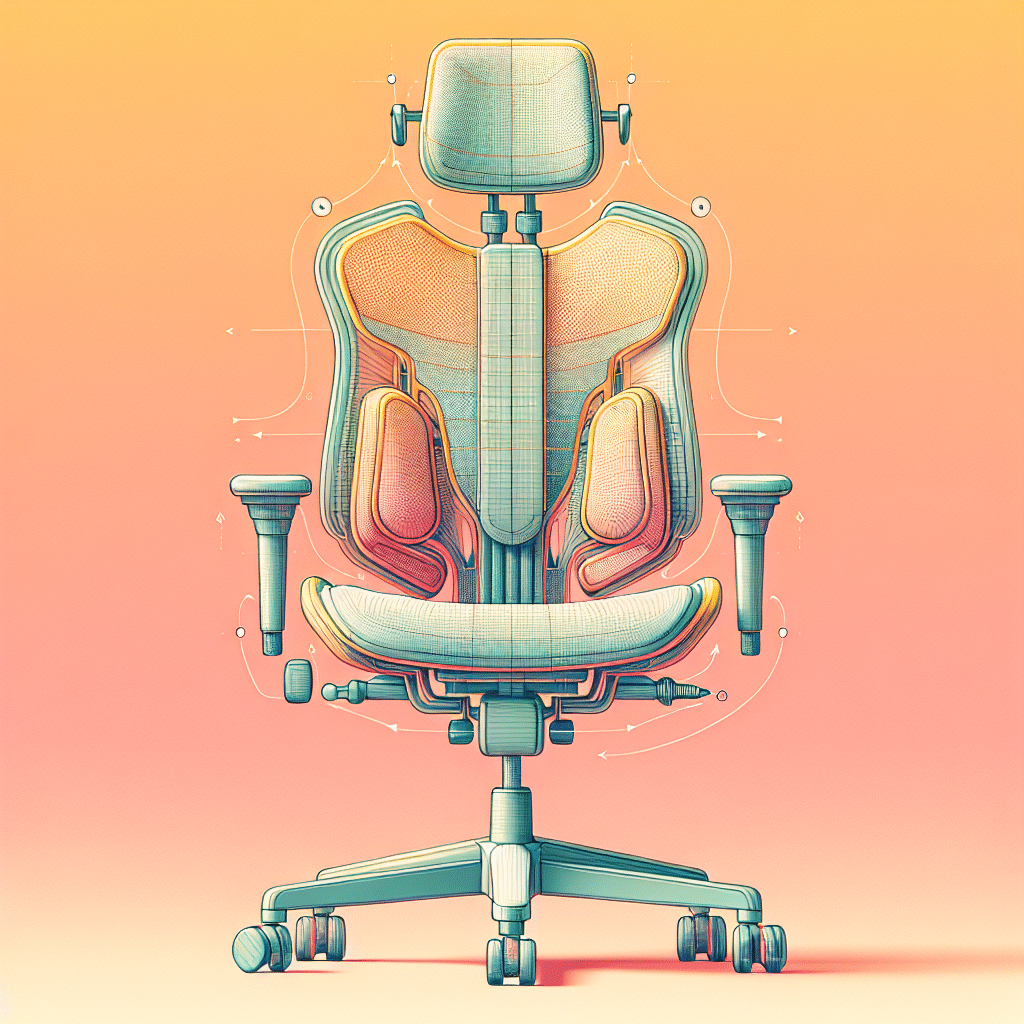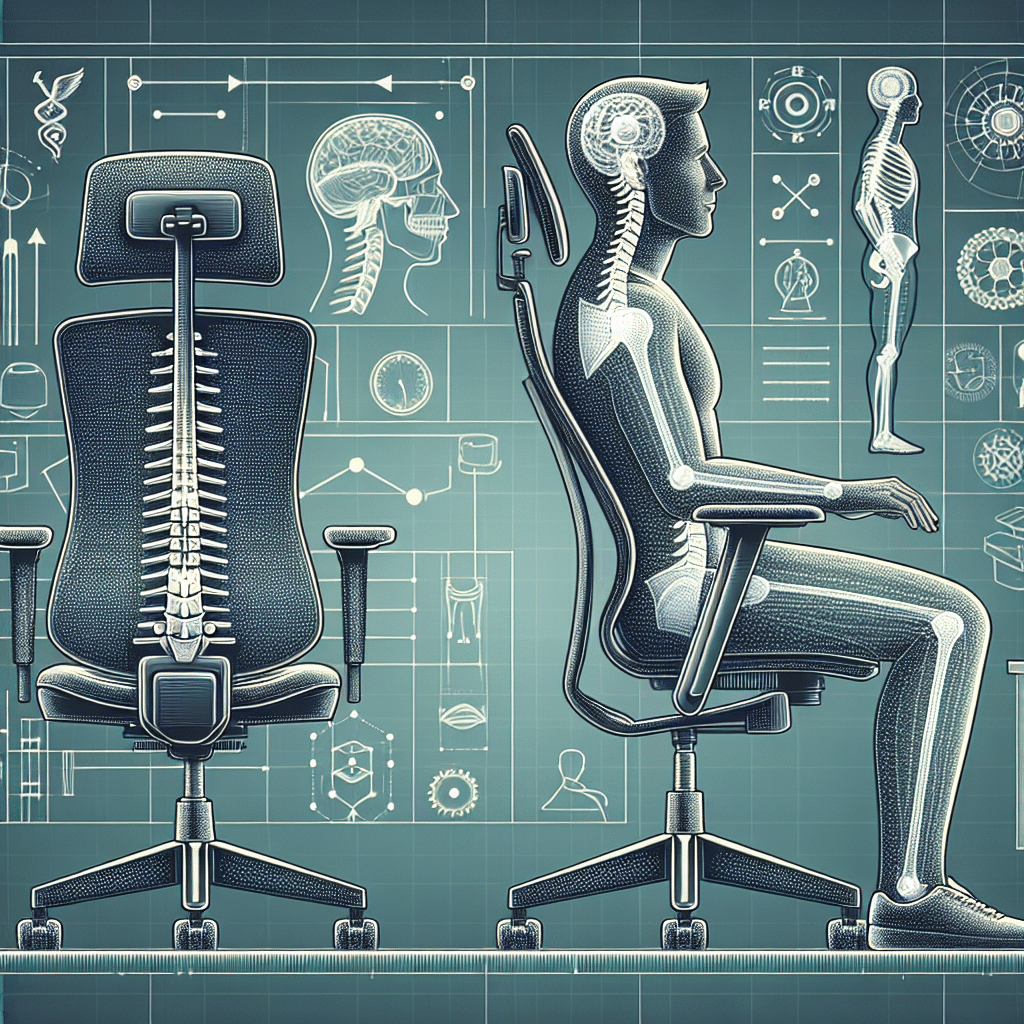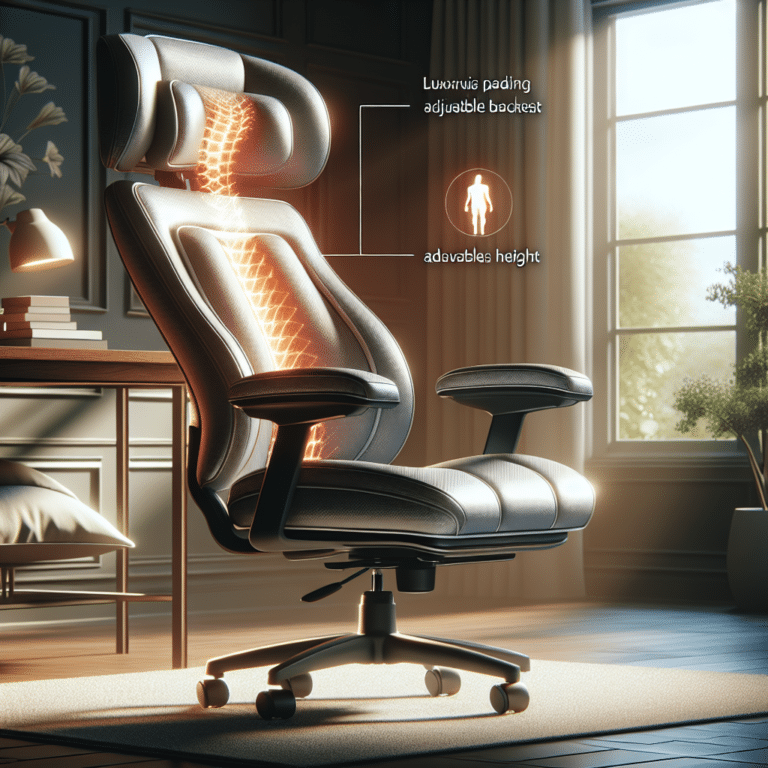Beginner’s Guide: Understanding Ergonomic Chair Features
Whether you’re setting up your home office or looking for the perfect chair for long hours at work, understanding the features of an ergonomic chair is crucial for your comfort and well-being. From adjustable height and lumbar support to swivel capabilities and tilt functions, this beginner’s guide will walk you through the different features you need to consider when choosing an ergonomic chair. With this knowledge at your fingertips, you’ll be able to make an informed decision and find the perfect chair that supports your posture and reduces the risk of discomfort and strain. So, let’s dive into the world of ergonomic chair features and create a comfortable and productive space for yourself.

The Fundamentals of Ergonomic Chairs
Definition and Purpose of Ergonomic Chairs
Ergonomic chairs are specially designed seating options that prioritize comfort and support while also promoting good posture and reducing the risk of musculoskeletal disorders. These chairs are specifically engineered to adapt to the unique needs of the human body, providing individuals with a comfortable and healthy sitting experience. The primary purpose of ergonomic chairs is to alleviate physical discomfort and prevent long-term health issues that can arise from prolonged sitting.
The Importance of Ergonomics in Seating
Ergonomics is the science of designing and arranging objects in a way that maximizes efficiency and user comfort. When applied to seating, ergonomics plays a crucial role in ensuring that individuals are properly supported while seated, especially in a work environment where people spend long hours working at their desks. By incorporating ergonomic principles into chair design, it becomes possible to reduce the risk of developing conditions like back pain, neck strain, and poor circulation.
The Relationship Between Ergonomic Chairs and Productivity
It may seem counterintuitive, but investing in ergonomic chairs can actually improve productivity in the workplace. When individuals are comfortable and supported in their seating, they are less likely to experience pain or discomfort that can distract them from their tasks. Moreover, a good ergonomic chair promotes proper posture, which can enhance concentration, focus, and overall cognitive function. By prioritizing the well-being of employees through ergonomic chairs, companies can potentially boost productivity levels and reduce absenteeism due to work-related injuries.
Identifying Key Ergonomic Features
As you begin your journey in understanding ergonomic chairs, it’s essential to familiarize yourself with the key features that make these chairs stand out from conventional seating options. Let’s explore each of these features in more detail.
Adjustable Seat Height
One of the fundamental features of ergonomic chairs is the ability to adjust the seat height according to individual preference and desk height. The ideal seat height allows your feet to rest flat on the floor or on a footrest, keeping your knees at a 90-degree angle. By maintaining proper alignment, you can alleviate pressure on your lower back and improve blood circulation in your legs.
Lumbar Support
Lumbar support refers to the part of the chair that helps maintain the natural curve of your lower spine, preventing slouching and promoting good posture. Ergonomic chairs provide adjustable lumbar support, allowing you to customize the intensity or height of the support to fit your unique body shape. Proper lumbar support reduces strain on your lower back and minimizes the risk of developing chronic back pain.
Adjustable Backrest
The ergonomic backrest plays a vital role in supporting your upper body and maintaining the natural curves of your spine. A good ergonomic chair offers different features to adjust the backrest, such as tilt mechanism and recline angle. This allows you to lean back comfortably, promoting relaxation during short breaks and reducing the pressure on your spine.
Seat Depth and Width
Finding the right seat depth and width is crucial for optimal comfort and support. The seat depth refers to the distance between the front and back edges of the chair, while the seat width determines the space available for your hips. When sitting in an ergonomic chair, you should have enough room for your thighs to be parallel to the ground, and your hips should be comfortably supported without any pressure points.
Armrests: Adjustability and Position
Armrests play a significant role in reducing strain on your neck, shoulders, and upper body. Ergonomic chairs typically provide adjustable armrests that can be customized to fit your preferred height and angle. Properly positioned armrests ensure that your arms and shoulders are relaxed, allowing for improved blood flow and reduced muscle tension.
Materials: Breathability and Durability
The choice of materials for your ergonomic chair can greatly affect your comfort and the chair’s longevity. Chairs with breathable materials like mesh or fabric promote airflow, preventing moisture accumulation and improving ventilation. Additionally, durable materials ensure that your chair lasts for an extended period without showing signs of wear and tear.
Adjustable Seat Height Explained
The Ideal Seat Height Range
Finding the ideal seat height is crucial for maintaining proper posture and reducing strain on your body. When seated, your feet should rest flat on the floor or on a footrest, with your knees bent at a 90-degree angle. The proper seat height supports the natural alignment of your spine and promotes good blood circulation in your legs.
How to Adjust Your Seat Height
Adjusting the seat height of your ergonomic chair is typically easy and straightforward. Most chairs have a lever or button located beneath the seat that allows you to raise or lower the seat to your desired height. Start by standing in front of the chair and adjusting the seat height so that it aligns with the middle of your kneecap. Sit down and check if your feet are flat on the floor or footrest. If the height feels uncomfortable, make adjustments until you find the perfect position.
The Impact of Seat Height on Posture
Maintaining the correct seat height is essential for promoting good posture. If your chair is too low, it can cause you to slouch, putting strain on your back and neck. Conversely, if your chair is too high, it can create pressure on your thighs and disrupt blood circulation. By finding the optimal seat height, you can achieve proper alignment of your spine, reduce the risk of posture-related issues, and ensure long-lasting comfort while seated.
The Importance of Lumbar Support
What is Lumbar Support?
Lumbar support refers to the ergonomic feature in chairs that helps maintain the natural curvature of your lower spine. This support can take the form of built-in lumbar pads, adjustable height and depth, or inflatable lumbar cushions. The primary purpose of lumbar support is to reduce the strain on your back, prevent slouching, and promote correct spinal alignment.
Adjusting Lumbar Support to Fit Your Spine
Each person has a unique spine curvature, and it’s important to adjust lumbar support to match your specific needs. Many ergonomic chairs offer adjustable lumbar support, allowing you to customize the level of support or position of the lumbar pad. Experiment with different settings to find the sweet spot that provides maximum comfort and maintains the natural curve of your lower back.
The Health Benefits of Proper Lumbar Support
Proper lumbar support has numerous health benefits. By maintaining the natural curvature of your lower back, you can alleviate pressure on your spinal discs and reduce the risk of developing back pain or injuries. Adequate lumbar support also helps distribute your weight evenly, promoting better blood flow and preventing muscle fatigue. Additionally, supporting the lumbar region can improve your overall posture and prevent the onset of chronic conditions caused by poor spinal alignment.

Understanding the Adjustable Backrest
Tilt Mechanism and Angle Recline
The adjustable backrest is a crucial feature in ergonomic chairs as it allows you to recline the chair and find a comfortable position for your back. Most ergonomic chairs have a tilt mechanism that enables you to recline the backrest and adjust the angle of recline. This feature is particularly beneficial during short breaks or when you need to change your sitting posture to relieve muscle tension.
Locking the Backrest for Stability
While the ability to recline is important, stability is also key when using an ergonomic chair. Many chairs come with a locking mechanism that allows you to lock the backrest at a specific angle, ensuring that it remains stable and doesn’t move unintentionally. This feature is especially useful when you want to maintain a fixed position during focused tasks or when you prefer a more upright posture.
Backrest Height and Pressure Customization
The height of the backrest is another adjustable feature in ergonomic chairs. By raising or lowering the backrest height, you can provide adequate support for your entire back, including your upper and lower back regions. Additionally, some chairs offer customizable pressure settings, enabling you to adjust the amount of resistance or tension in the backrest, providing individualized comfort and support.
The Role of Seat Depth and Width
Finding the Right Seat Depth
Seat depth is an important aspect of ergonomic chair design that greatly impacts your sitting comfort. A seat that is too shallow can cause discomfort and pressure points behind your knees, while a seat that is too deep can restrict blood circulation in your legs. The ideal seat depth allows you to sit with your back against the backrest and have a few inches of space between the edge of the seat and the back of your knees.
The Impact of Seat Width on Hip Comfort
Seat width is another crucial factor in determining the comfort of an ergonomic chair. If the seat is too narrow, it can exert pressure on your hips and thighs, leading to discomfort and poor circulation. On the other hand, a seat that is too wide can cause you to slouch or sit asymmetrically, compromising your posture. It’s important to find a seat width that accommodates your body size and allows you to sit comfortably with your thighs parallel to the ground.
Adjusting the Seat for Proper Leg Circulation
To ensure optimal leg circulation, it’s important to adjust the seat depth and width accordingly. When seated, your feet should rest flat on the floor or on a footrest, and your knees should be at a 90-degree angle. This position promotes healthy blood flow in your legs and prevents numbness or tingling. Adjust the seat depth and width of your ergonomic chair until you find a position that provides adequate support and unrestricted circulation.
Armrests: A Critical Component for Comfort
The Height of Armrests and Upper Body Support
Armrests are a critical component of ergonomic chairs as they provide support and alleviate strain on your upper body. Adjustable armrests allow you to find the perfect height that keeps your arms relaxed, shoulders comfortable, and neck aligned. The ideal armrest height is one that supports your forearms without causing your shoulders to hunch or your wrists to bend upward.
Adjustable Armrests for Different Tasks
Different tasks require varying degrees of arm support, and that’s where the adjustability of armrests becomes essential. Some ergonomic chairs offer multi-dimensional armrest adjustments, allowing you to adjust the height, width, and angle of the armrests. This flexibility enables you to customize the armrests to suit various activities, such as typing, writing, or simply resting your arms during breaks.
The Link between Arm Position and Neck/Shoulder Strain
The position of your arms plays a significant role in reducing strain on your neck and shoulders. Improper arm positioning, such as reaching forward or holding them too high, can lead to muscle tension and discomfort. By utilizing adjustable armrests, you can position your arms at a height that supports your shoulders and keeps them relaxed. This promotes proper alignment and reduces the risk of developing neck and shoulder pain.
Choosing the Right Materials for Your Ergonomic Chair
Fabric versus Mesh versus Leather
When selecting an ergonomic chair, one must consider the materials used for the seat and backrest. Common options include fabric, mesh, and leather. Each material has its own set of advantages and considerations. Fabric chairs are often comfortable and breathable, allowing for airflow, but they may be susceptible to staining. Mesh chairs offer excellent breathability and conform to body contours, but they may lack padding. Leather chairs are known for their durability and luxurious feel, but they may not provide as much breathability as fabric or mesh options.
The Role of Foam Density in Cushioning
Another important aspect to consider in choosing an ergonomic chair is the density of the foam used in the seat and backrest. Foam density affects the comfort and support provided by the chair. High-density foam provides firm support, ensuring that the chair maintains its shape over time. However, it may feel too rigid for some individuals. Low-density foam offers a softer and more cushioned feel, but it may compress and lose its shape more quickly. It’s essential to strike a balance between comfort and durability when deciding on the foam density for your ergonomic chair.
Maintenance and Longevity of Chair Materials
It’s important to assess the maintenance requirements and longevity of the materials used in your ergonomic chair. Some materials may require more frequent cleaning or conditioning to maintain their appearance and durability. Leather, for example, needs periodic cleaning and conditioning to prevent cracking and drying out. On the other hand, fabric or mesh chairs may require more frequent vacuuming or spot cleaning to remove dust and stains. It’s crucial to follow manufacturer recommendations for each specific material to ensure its long-term quality and performance.
Navigating the Adjustment Mechanisms
Types of Chair Adjustment Controls
Ergonomic chairs often feature various adjustment mechanisms that allow you to personalize your sitting experience. Common adjustment controls include seat height adjustment, backrest tilt and recline, lumbar support adjustment, and armrest adjustments. Understanding how each control works and how it affects your comfort is key to maximize your chair’s ergonomic potential.
Common Adjustment Mechanism Issues
While ergonomic chairs are designed to be user-friendly, there may be some common issues that arise with the adjustment mechanisms. For example, certain parts may become loose over time or require occasional lubrication for smooth operation. It’s important to be aware of these potential issues and contact the manufacturer or a professional if you encounter any difficulties in adjusting your chair.
DIY Troubleshooting for Chair Adjustments
In some cases, you may be able to troubleshoot and resolve minor adjustment issues on your own. For example, if the seat height adjustment lever is not functioning properly, ensuring that all the screws are tightened and properly aligned can often fix the problem. Additionally, referring to the chair’s user manual or contacting customer support for guidance can help you navigate through any DIY troubleshooting needed.
Additional Ergonomic Features to Consider
Headrests and Neck Support
While not all ergonomic chairs have headrests, they can be beneficial for individuals who require additional support for their neck and head. A headrest helps maintain proper alignment of the cervical spine, reducing strain on the neck and shoulders. When choosing an ergonomic chair with a headrest, ensure that it is adjustable in height and angle to provide optimal support for your specific needs.
Seat Tilt and Tension Control
Some ergonomic chairs offer seat tilt and tension control features, allowing you to adjust the angle of the seat and the level of resistance when reclining. This feature can be particularly useful for individuals who prefer dynamic seating, as it enables freedom of movement while maintaining proper support and stability.
Swivel Base and Mobility
Most ergonomic chairs come with a swivel base, allowing users to rotate the chair without straining or twisting their bodies. This feature enhances mobility and flexibility in a workstation, enabling individuals to easily reach different areas of their workspace without exerting unnecessary effort.
Integrated Technological Add-ons
With the advancement of technology, some ergonomic chairs incorporate additional features such as built-in USB ports, wireless charging pads, or even integrated massage functions. These technological add-ons can enhance comfort and productivity, allowing individuals to stay connected and relax during long work hours.
In conclusion, understanding the fundamentals of ergonomic chairs is crucial for promoting comfort, productivity, and overall well-being in the workplace and beyond. By familiarizing yourself with the key ergonomic features, adjusting your chair to fit your body properly, and considering additional features that suit your needs, you can find the perfect ergonomic chair that supports your health and enhances your sitting experience. Remember, investing in your own comfort and ergonomic needs is a worthwhile endeavor that can have significant long-term benefits for your physical health and productivity.








